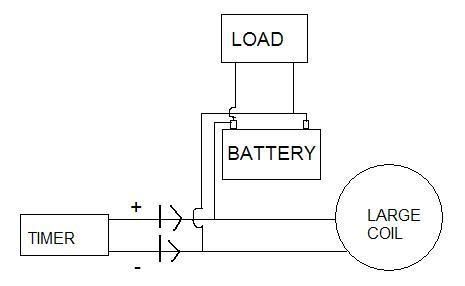Hi Guys,
Reading and learning as much as I can here, but still know very little about electronics. Please ponder this:
The bigger the "Inductor", the bigger the "Inductance", correct?
Example: On Page 25 of this document http://free-energy-info.co.uk/Newman1.pdf Joe Newman states that if we take an air coil of 40 gauge wire , 1000 feet long, and having a resistance of 1,049 ohms, then pulse a 100 Volt, 95 Milliamp current to it, that the resulting inductance would be .003 henries. No big deal, right?
But then he goes on to say, that if we take that same 100 Volt, 95 Milliamp current and put it into a much larger coil, say 5 gauge wire, measuring 3,348,000 feet, to EQUAL the EXACT same resistance as above of 1,049 ohms, that the inductance is now a phenomenal 8,000,000 times greater, or a whopping 25,700 Henries!
Patrick Kelly also states on Page 22 of this document Practical Guide to Free-Energy Devices - eBook Download "So, just to get it straight in your mind, when you make a battery, the chemical action inside the battery creates a Plus terminal and a Minus terminal. Those poles actually distort the universe around your battery, and causes vast streams of energy to radiate out in every direction from each pole of the battery. Why doesn't the battery run down? Because the energy is flowing from the environment and not from the battery. If you were taught basic physics or electrical theory, you will probably have been told that the battery used to power any circuit, supplies a stream of electrons which flows around the circuit. Sorry Chief - it just aint like that at all. What really happens is that the battery forms a "dipole" which nudges the local environment into an unbalanced state which pours out energy in every direction, and some of that energy from the environment flows around the circuit attached to the battery. The energy does NOT come from the battery."
Most of the people building motors on here are probably just going to try and hook it to a generator anyway for some type of electricity generation.
So..............my question is this: Why aren't we just pulsing larger coils????
Why do we need motors, spinning magnets, spinning wheels, rotors, brushes, commutators, etc.
Wouldn't it be simpler just to pulse larger coils with a chip or oscillator?
Obviously, the example above with 3,348,000 feet of 5 gauge wire (and weighing 335,469 pounds) is a little extreme, but what about 10 pound coils, or 20 pound coils, or 50 pound coils?
What about wrapping some coils of wire around that car sitting in our driveway or garage that never moves. Would the iductance created be the equivilant of a much larger coil?
If any of this sounds viable, what would such a circuit look like? Anything like this?

Reading and learning as much as I can here, but still know very little about electronics. Please ponder this:
The bigger the "Inductor", the bigger the "Inductance", correct?
Example: On Page 25 of this document http://free-energy-info.co.uk/Newman1.pdf Joe Newman states that if we take an air coil of 40 gauge wire , 1000 feet long, and having a resistance of 1,049 ohms, then pulse a 100 Volt, 95 Milliamp current to it, that the resulting inductance would be .003 henries. No big deal, right?
But then he goes on to say, that if we take that same 100 Volt, 95 Milliamp current and put it into a much larger coil, say 5 gauge wire, measuring 3,348,000 feet, to EQUAL the EXACT same resistance as above of 1,049 ohms, that the inductance is now a phenomenal 8,000,000 times greater, or a whopping 25,700 Henries!
Patrick Kelly also states on Page 22 of this document Practical Guide to Free-Energy Devices - eBook Download "So, just to get it straight in your mind, when you make a battery, the chemical action inside the battery creates a Plus terminal and a Minus terminal. Those poles actually distort the universe around your battery, and causes vast streams of energy to radiate out in every direction from each pole of the battery. Why doesn't the battery run down? Because the energy is flowing from the environment and not from the battery. If you were taught basic physics or electrical theory, you will probably have been told that the battery used to power any circuit, supplies a stream of electrons which flows around the circuit. Sorry Chief - it just aint like that at all. What really happens is that the battery forms a "dipole" which nudges the local environment into an unbalanced state which pours out energy in every direction, and some of that energy from the environment flows around the circuit attached to the battery. The energy does NOT come from the battery."
Most of the people building motors on here are probably just going to try and hook it to a generator anyway for some type of electricity generation.
So..............my question is this: Why aren't we just pulsing larger coils????
Why do we need motors, spinning magnets, spinning wheels, rotors, brushes, commutators, etc.
Wouldn't it be simpler just to pulse larger coils with a chip or oscillator?
Obviously, the example above with 3,348,000 feet of 5 gauge wire (and weighing 335,469 pounds) is a little extreme, but what about 10 pound coils, or 20 pound coils, or 50 pound coils?
What about wrapping some coils of wire around that car sitting in our driveway or garage that never moves. Would the iductance created be the equivilant of a much larger coil?
If any of this sounds viable, what would such a circuit look like? Anything like this?


 .
.




Comment